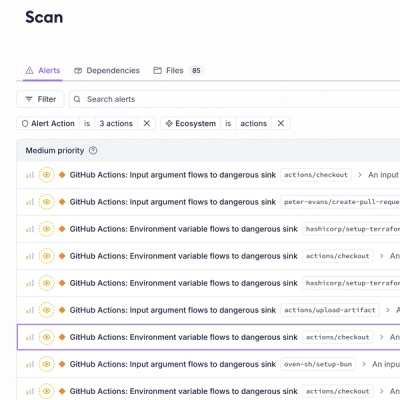
Product
Introducing Socket Firewall Enterprise: Flexible, Configurable Protection for Modern Package Ecosystems
Socket Firewall Enterprise is now available with flexible deployment, configurable policies, and expanded language support.
@nftstorage/metaplex-auth
Advanced tools
A client library for nft.storage designed for metaplex NFT uploads
This repo contains a client library for uploading data to NFT.Storage using a signature from a solana private key to authenticate the request.
See SPEC.md for details about the authentication scheme.
npm install @nftstorage/metaplex-auth
or
yarn add @nftstorage/metaplex-auth
This package is primarily intended to be used as a library in your JavaScript or TypeScript project.
API reference docs can be found at https://nftstorage.github.io/metaplex-auth/
The main entry point into the API is the NFTStorageMetaplexor class, which provides methods for uploading files to NFT.Storage.
To create an NFTStorageMetaplexor, you'll need either a Solana private signing key or a signMessage function that can return a valid Ed25519 signature for a Solana account (for example, from a wallet adapter).
The methods for creating an NFTStorageMetaplexor also require a mintingAgent string.
The mintingAgent should identify the tool or platform used to prepare the upload.
Projects using this library are free to choose their own value for this tag, however you should avoid changing the name over time, unless the project itself changes names (for example, due to a community fork or re-branding).
For personal projects or individuals creating tools that are not affiliated with a public platform, please set the value to a URL for your code repository. If your code is not yet public, please create a repository containing a description of the project and links to its public-facing interface.
Examples of suitable values:
"metaplex/candy-machine-cli""metaplex/js-sdk""magiceden/mint-authority""https://github.com/samuelvanderwaal/metaboss"You may also optionally pass an agentVersion string, to differentiate between different versions of your project.
The NFTStorageMetaplexor.withSecretKey static method accepts a Uint8Array containing a secret Ed25519 signing key.
It also optionally accepts an options object that can be used to set some metadata about the request. Most importantly, you should set the solanaCluster option to the cluster you intend to mint on. If not provided, it will default to devnet.
import { NFTStorageMetaplexor } from '@nftstorage/metaplex-auth'
const key = loadKeyFromSomewhere()
const client = NFTStorageMetaplexor.withSecretKey(key, {
solanaCluster: 'mainnet-beta',
mintingAgent: 'my-awesome-tool',
})
If you're using a wallet adapter that supports the signMessage function, you can use it with the NFTStorageMetaplexor.withSigner static method by passing in the signMessage function and the public key.
import { NFTStorageMetaplexor } from '@nftstorage/metaplex-auth'
import { useWallet } from '@solana/wallet-adapter-react'
const MyComponent = () => {
const { publicKey, signMessage } = useWallet()
const client = NFTStorageMetaplexor.withSigner(signMessage, publicKey, {
solanaCluster: 'mainnet-beta',
mintingAgent: 'my-awesome-tool',
})
}
To assist with uploading Metaplex NFTs, this package includes support for loading Metaplex NFT metadata and uploading files that are referenced within.
The storeNFT methods will validate the metadata using a JSON schema to catch any formatting errors before upload.
Please note that the schema validation code has not been widely tested yet on real-world NFT data and may be too restrictive. If you believe that it is rejecting valid metadata, please open an issue.
If you're using node.js, you can use the NFTStorageMetaplexor.storeNFTFromFilesystem method to load NFT data from disk and upload it in one operation.
async function uploadNFT(pathToMetadataJson) {
const key = loadKeyFromSomewhere()
const client = NFTStorageMetaplexor.withSecretKey(key)
const result = await client.storeNFTFromFilesystem(pathToMetadataJson)
}
If you're running in a browser, you'll need to use the prepareMetaplexNFT function, which accepts metadata as a JS object and takes File objects containing image and other asset data. The resulting PackagedNFT object can be passed into the storePreparedNFT method.
The prepareMetaplexNFT and storeNFTFromFilesystem methods will upload the image, animation_url and any files contained in properties.files if they contain valid file references.
In the case of prepareMetaplexNFT, the provided imageFile parameter will be uploaded, along with any additionalAssetFiles. The image field in the metadata will be replaced with an HTTP gateway URL to the uploaded image. Likewise, if the animation_url field contains the name of one of the additionalAssetFiles, the field will be replaced with a gateway URL.
All entries in properties.files will likewise be replaced with IPFS links if the uri field contains the filename of any of the uploaded files. Each uploaded file will contain two entries in the final metadata: one containing an HTTP gateway URL with the cdn flag set to true, and one location-independent ipfs:// URI with cdn set to false. This should allow clients to fetch content over HTTP while still preserving a location-independent link that doesn't depend on a single gateway.
When using storeNFTFromFilesystem on node.js, the same rules apply, however you don't need to pass in File objects for each asset. Instead, you can set the image field (and optionally, animation_url) to a file path relative to the metadata JSON file, and the image data will be loaded from disk. Likewise, any entries in properties.files whose uri contains a valid file path will be uploaded, and the entry will be replaced with two IPFS links as with prepareMetaplexNFT.
You can upload arbitrary files using the storeDirectory method. It accepts an Iterable of File objects and bundles them into an IPFS directory listing, returning the root CID of the stored directory.
async function uploadFiles(files) {
const key = loadKeyFromSomewhere()
const client = NFTStorageMetaplexor.withSecretKey(key)
const cid = await client.storeDirectory(files)
console.log(
`Stored ${files.length} file(s). Check them out at https://${cid}.ipfs.nftstorage.link`
)
}
Note that the returned CID links to a directory object containing the files. If you want to link to individual files within the directory, you must append the filename to the result:
async function uploadFiles(files) {
const key = loadKeyFromSomewhere()
const client = NFTStorageMetaplexor.withSecretKey(key)
const cid = await client.storeDirectory(files)
// make HTTP gateway links using the nftstorage.link gateway
const gatewayBaseUrl = new URL(`https://${cid}.ipfs.nftstorage.link`)
const gatewayLinks = files.map((f) => new URL(f.name, gatewayBaseUrl))
// make gateway-agnostic IPFS uris:
const uriBase = new URL(`ipfs://${cid}`)
const ipfsURIs = files.map((f) => new URL(f.name, uriBase))
}
Under the hood, all the upload methods encode data into IPFS Content Archives (CARs) before uploading.
If you already have CAR-formatted data, you can upload it with the storeCar method.
This may be useful if you have already imported your data into IPFS, or if you want to have more control over the object graph, for example, because you want to use IPLD to store structured data.
The storeCar method accepts a CarReader from the @ipld/car package.
FAQs
A client library for nft.storage designed for metaplex NFT uploads
We found that @nftstorage/metaplex-auth demonstrated a not healthy version release cadence and project activity because the last version was released a year ago. It has 6 open source maintainers collaborating on the project.
Did you know?

Socket for GitHub automatically highlights issues in each pull request and monitors the health of all your open source dependencies. Discover the contents of your packages and block harmful activity before you install or update your dependencies.

Product
Socket Firewall Enterprise is now available with flexible deployment, configurable policies, and expanded language support.

Security News
Open source dashboard CNAPulse tracks CVE Numbering Authorities’ publishing activity, highlighting trends and transparency across the CVE ecosystem.

Product
Detect malware, unsafe data flows, and license issues in GitHub Actions with Socket’s new workflow scanning support.